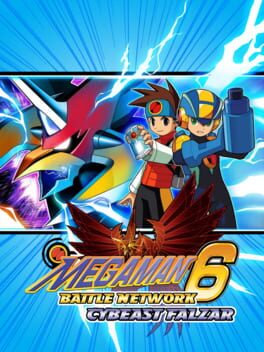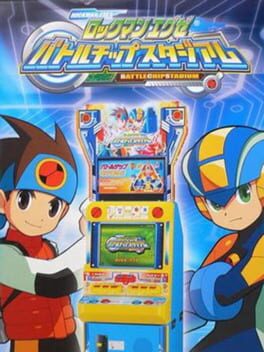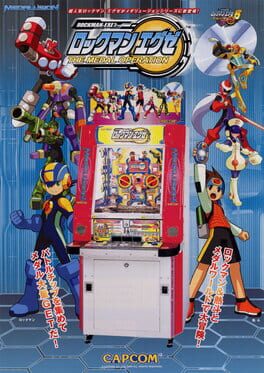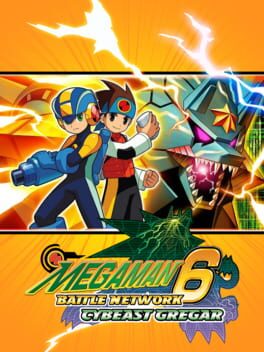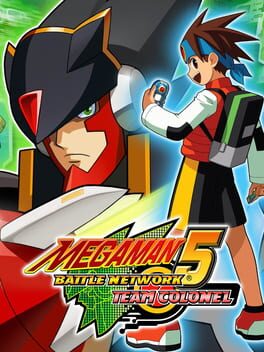

Mega Man Battle Network 6: Cybeast Falzar
released on Nov 23, 2005
In Mega Man Battle Network 6, Lan's father has received a job transfer and the family moves to Cyber City, a town known for conducting various technological experiments. Lan will meet new people and build new friendships in the real world while Mega Man befriends helpful Navis and encounters dangerous new enemies on the virtual plane. Together they will face threats far more powerful and perilous than they ever have before.
Also in series
Reviews View More
It's perhaps a condemnation of this series that this is only among the worst-written BN games. Where previous games explored ways a near-future society could look and the cast of kids had fun interactions building narrative arcs, BN6 is just full shonen nonsense. Its writing rarely demonstrates any of the care or joy that I'm certain went into it, unlike the time-crunch panic constantly evident in its creative decisions. The story is an unrewarding slog and the side-content is actively nothing.
And yet, the fight mechanics are better than they've ever been. It reminds me of Quake II, actually - another game whose singleplayer experience was poor but kicked ass as a multiplayer game. Quake II was creatively barren where BN6 is rife with legitimately interesting ideas (Copybots! Playing as other Navis! alright that's it) that get maybe 30% of the way there. But they're both damn fun to play with others! Nearly two decades later and BN6 still has a competitive scene - one that survived the colossal lull where Capcom barely acknowledged the spinoff series' existence.
I can't recommend playing this unless you're a BN series diehard (in which case, you probably already have) or you're a sweaty tryhard with one or more friends playing alongside you and NetBattling you at every turn. Narratively, it's disappointing the series went out with a whimper - but the sterling fight mechanics keeping the MMBN legacy alive makes this a bittersweet entry.
Played on MMBN Legacy Collection live on [The Neon Caster's channel]
And yet, the fight mechanics are better than they've ever been. It reminds me of Quake II, actually - another game whose singleplayer experience was poor but kicked ass as a multiplayer game. Quake II was creatively barren where BN6 is rife with legitimately interesting ideas (Copybots! Playing as other Navis! alright that's it) that get maybe 30% of the way there. But they're both damn fun to play with others! Nearly two decades later and BN6 still has a competitive scene - one that survived the colossal lull where Capcom barely acknowledged the spinoff series' existence.
I can't recommend playing this unless you're a BN series diehard (in which case, you probably already have) or you're a sweaty tryhard with one or more friends playing alongside you and NetBattling you at every turn. Narratively, it's disappointing the series went out with a whimper - but the sterling fight mechanics keeping the MMBN legacy alive makes this a bittersweet entry.
Played on MMBN Legacy Collection live on [The Neon Caster's channel]
By the time you roll the credits on Battle Network 6, it’s evident that the series has reached its conclusion. Previous games have always left the player on a triumphant note: having defeated the latest world-threatening evil, Lan and his friends celebrate, secure in the knowledge that, should such another menace disrupt their beatific adolescence (as they so often do), Lan and Mega Man will rise to the occasion and thwart their schemes again—and in the process, work up a much-deserved appetite while frantically forgetting his homework, as ever. But Battle Network 6 ends a bit differently. In addition to the routine celebration we get a scene of all the characters looking towards their future, finally having graduated from elementary school and considering where they’d like to be in twenty years. It would seem that development did not begin with this intent of denouement in mind, but regardless, a conclusion for the series was always inevitable, and the provided closure for the characters is appreciated, but insubstantial. The bittersweet feeling you’re left with is more the result of a want of a proper conclusion, the hollow sentimentality lingering in your chest as you ponder how impactful such a culmination should feel after six consecutive entries. The hastily constructed epilogue is in part to blame, providing details of the characters’ futures without actually giving us the satisfaction of seeing these ambitions come to fruition, but the relative disappointment of this final entry derives more from the totality of the experience leading up to this lackluster finale. While it never feels like a bad game during its duration, and certainly greater than the series’ nominal low points, the experience nonetheless fails to conjure the same spirit and personality which has propelled the franchise up to this regrettable end.
Conversely, one could argue that this is the pinnacle of the franchise, from a gameplay perspective at the very least. With five entries preceding it, refining and expanding the various mechanics of the series, would that not be the logical result? But for all this provides, the inclusion of all these features often lacks cohesion, resulting in a series of systems which theoretically synergize together, but in practice often render one another moot in the vast majority of situations. The primary example is the titular new draw: the Cybeasts. The story this time centers around these near-mythical titans of the net, uncontrollable behemoths sealed away during the early era of the age, yet conveniently never mentioned before despite establishing a link to a similar beast from a prior title. In order to prevent their rampage, Mega Man must absorb one into his body (somehow), and thus take on its attributes in combat. This new transformation gimmick exists alongside the preserved transformation gimmicks of the previous games, refined and rebranded as the Cross System. These two mechanics can operate in tandem to give Mega Man’s Beast Mode the elemental effects of the respective Navis of the Cross System. The increased power level and flexibility these powers supply can be rewarding, but the flash and spectacle that accompany them more often disrupt the flow of combat and delay the completion of most encounters. On top of that, the two systems contradict one another when it comes to deckbuilding, as the various Cross Navis encourage you to include corresponding elemental chips to multiply their damage, while the Cybeast’s power demands non-elemental chips to unlock its full potential. And while this theoretically should reward a diverse composition of varied chip types, the Beast Mode’s powers trump that of the elemental Navis even when combined together. Although this newest mechanic initially appears exciting, evolutionary, and engaging, it proves to be quite unnecessary, and even tedious, in most situations in the game, and even ends up clashing with the retained transformation system of the previous games.
But perhaps this underwhelming combination of ideas has more to do with a lack of thematic cohesion rather than their mechanical failings, as in spite of their nominal flaws, both the Beast Mode and Cross Systems do present situationally rewarding gameplay. The draw of these colossal titans is ostensibly the spectacle of their gargantuan nature, but despite a relatively convincing backstory, their presence feels incongruous to the aesthetic and environment of the cyber world rendered so far. Thus, it necessitates a complete change in setting for the story, a completely new destination for the series, comprised of largely uninspired locales with often bizarre theming that threatens the fragile credulity of this already fanciful series. The biggest culprit here comes in the game’s fourth scenario, the second new overworld destination you can travel to about halfway through the game. Revisiting a concept from the series’ third entry, the centerpiece of this area is a cybernetically-enhanced tree, only instead of operating as the central computer of a hospital, its function is to pass judgements as an artificial intelligence programmed to hand down the most perfect verdicts as an unbiased arbiter of justice. The Judge Tree, as it’s called, operates as the nucleus of this order-obsessed town, combining together principles of legalism and environmentalist imagery to create an Orwellian vision of a technologically-incorporated justice system. All this is just a bit too heady for a series like this, even before it’s revealed that the Judge Tree is the product of one of the prosecutors who still actively participates in trials alongside the program he invented to hand down verdicts. The game clearly has no interest in the drastic moral questions all this brings to mind, as it’s solely designed as a smokescreen for an unsurprising villain reveal partway through the scenario. Still, the philosophical implications linger for anyone aware enough to ponder, and the quandaries they present are uncomfortably discordant to the straightforward dichotomy of conflict the series has always committed to.
The other areas of the game suffer from the inverse of this contrivance: overly simplistic design and theming. In addition to Green Town, the Sea and Sky themed areas offer little more than their names imply, seemingly serving only a single function for the entire city, consisting of an aquarium and weather center respectively. These kinds of singular identities for a destination aren’t necessarily unknown to prior entries, but by the sixth game in the series you’d expect things to improve, or at least resemble some of the more distinct and memorable examples of the past. Battle Network 6’s locales just feel so bland, so by-the-numbers. They lack the signature personality which propel the previous titles, hampered further by the distinctly uninspired villains and Navis who terrorize these places. The first two scenarios don’t exhibit this issue nearly as much as later chapters, as both Blastman and Diveman sport memorable character designs and fairly benign dungeon scenarios which, at the very least, remain in line with the straightforward and contained design of previous entries. It’s towards the latter half of the game things get tedious, especially when the main antagonist is initially revealed to be a former friend of the franchise. You go the whole game expecting, or at the very least hoping, that there will be some sort of satisfying explanation for this sudden motivational reversal. Their characterization up to the climax feels sloppy and inconsistent from what was established before, and you think maybe there could still be some magical explanation that’ll put all the pieces into place when you get to the end. But the shoddy writing is exactly that, and the explanation you’re given is just some contrived backstory that doesn’t gel at all with how this character was previously presented, and it’s clear that the story was only taken in this direction to create some forced dramatic conflict. It’s perhaps the biggest disappointment of the entire game, which itself was struggling to deliver the same level of flavorful presentation of prior games thanks to the muddled execution of everything from its narrative to its overwrought battle mechanics.
But it’s not all bad, and in fact, Battle Network 6 excels in areas many might find redeeming enough to more or less forgive the procession of poorly-considered narrative conceits. For one thing, the chip variety and code synergy between chips has never been better. Even from very early on in the game, you have a host of options in terms of how you want to build your folder, with a plethora of viable codes that allow you to combo chips together quite easily. On top of that, a new feature is introduced to make Program Advances far more reliable in combat, tagging together two of the three needed chips for an Advance so that they always show up on the Custom Screen together. Combined with the already handy Regular Chip feature, you’re practically guaranteed to get a Program Advance almost every battle. Many of your early chips this time also exhibit a significant power increase over prior entries, further assisting in trivializing the game’s transformation mechanics by allowing you to end most battles instantaneously with the right draw. The Battle System as a whole remains a paragon for the series, retaining all the beneficial features and mechanics developed over the last five games while continuing to find new ways to tweak certain elements to keep combat engaging and rewarding. Once again they expand on features introduced in the prior entry, allowing you to take control of ally Navis and learn to battle with their unique properties. While the Liberation Missions they were contained to in 5 were not carried over, you can now utilize them across the whole of the net, with the only restriction being that you need to start off from a specific area each time you enter. This limitation is actually a lot more discouraging than you might think, and it makes wanting to use each Navi to clear specific hazards across the net something of a chore, but it’s nice still that they found a means of retaining this fun feature in a way that still demands situational application.
Speaking of returning features, Battle Network 6 finally brings back side quests via the Request BBS, a much-beloved feature absent from the last two games. Side quests are an important mainstay of RPGs, as they can assist in the world-building and reward systems of a game while also helping to break up the pacing of a very direct and unceasing narrative. They do impose some odd limitations on it unfortunately, creating scenarios in which you’re able to accept certain jobs before you even have access to the area you’re meant to accomplish it in. And as with the previous games that featured this system, you can’t unaccept a job after you’ve committed to one, so you can end up unintentionally locking yourself out of completing jobs for a while. It’s slightly annoying that the jobs system still has some kinks, but ultimately I’m just glad to see it back after getting axed from the previous two titles. That’s about it, though, for truly positive praise of the game. Sure, there’s still an abundance of cromulent features rounding out the experience, but those are largely returning mechanics with little to no additional refinement from the last game. Smaller changes which might otherwise go unremarked are appreciated, such as an indication of an upcoming boss fight allowing players to recognize where they should save before starting a cutscene, but tiny refinements such as these hardly make a game, and ultimately pale in comparison to a lot of the game’s more unwieldy decisions.
I feel like a lot of the bitterness here stems from the fact that Battle Network 6 marks the end of the series. The most prominent qualms reside in the game’s poor characterization, rushed conclusion, and generally awkward theming, with the gameplay being more or less sound—no better or worse than in any other title, at least. But because it’s the end, and because things seem to fade out on a whimper, the dissatisfaction of the experience compounds, leading to that lingering sense of disappointment. While writing has never been a strong suit of the series, the personality imbued into the world through the story’s characters and perils has always been its lifeblood. Sure, the immersive and rewarding battle mechanics are what keep you playing, but it’s the flavor and presentation of this unique setting that hooks you to begin with. In certain ways, Battle Network 6 does deliver a satisfying conclusion for the series. It’s clunky and doesn’t really land with all the emotional weight it intends, but in a way that’s kind of par for the course. The Battle Network series as a whole is somewhat clunky, inconsistent in its quality across all six titles, with numerous peaks and valleys within each individual game determining the ultimate outcome of the experience. By that metric, Battle Network 6 is sort of the perfect Battle Network game; an encapsulation of all the enduring charm and squandered potential each entry possesses regardless of how terrific the final result ends up. What’s good remains good, and what’s bad is, well, not unheard of for the franchise. And although 6 manages to trip at the finish line, half-heartedly giving us some emotional closure for the characters we’ve grown to love over a lengthy series of games, it still possesses the unique attributes and heart which has been pivotal for the series since its unforgettable inception.
Conversely, one could argue that this is the pinnacle of the franchise, from a gameplay perspective at the very least. With five entries preceding it, refining and expanding the various mechanics of the series, would that not be the logical result? But for all this provides, the inclusion of all these features often lacks cohesion, resulting in a series of systems which theoretically synergize together, but in practice often render one another moot in the vast majority of situations. The primary example is the titular new draw: the Cybeasts. The story this time centers around these near-mythical titans of the net, uncontrollable behemoths sealed away during the early era of the age, yet conveniently never mentioned before despite establishing a link to a similar beast from a prior title. In order to prevent their rampage, Mega Man must absorb one into his body (somehow), and thus take on its attributes in combat. This new transformation gimmick exists alongside the preserved transformation gimmicks of the previous games, refined and rebranded as the Cross System. These two mechanics can operate in tandem to give Mega Man’s Beast Mode the elemental effects of the respective Navis of the Cross System. The increased power level and flexibility these powers supply can be rewarding, but the flash and spectacle that accompany them more often disrupt the flow of combat and delay the completion of most encounters. On top of that, the two systems contradict one another when it comes to deckbuilding, as the various Cross Navis encourage you to include corresponding elemental chips to multiply their damage, while the Cybeast’s power demands non-elemental chips to unlock its full potential. And while this theoretically should reward a diverse composition of varied chip types, the Beast Mode’s powers trump that of the elemental Navis even when combined together. Although this newest mechanic initially appears exciting, evolutionary, and engaging, it proves to be quite unnecessary, and even tedious, in most situations in the game, and even ends up clashing with the retained transformation system of the previous games.
But perhaps this underwhelming combination of ideas has more to do with a lack of thematic cohesion rather than their mechanical failings, as in spite of their nominal flaws, both the Beast Mode and Cross Systems do present situationally rewarding gameplay. The draw of these colossal titans is ostensibly the spectacle of their gargantuan nature, but despite a relatively convincing backstory, their presence feels incongruous to the aesthetic and environment of the cyber world rendered so far. Thus, it necessitates a complete change in setting for the story, a completely new destination for the series, comprised of largely uninspired locales with often bizarre theming that threatens the fragile credulity of this already fanciful series. The biggest culprit here comes in the game’s fourth scenario, the second new overworld destination you can travel to about halfway through the game. Revisiting a concept from the series’ third entry, the centerpiece of this area is a cybernetically-enhanced tree, only instead of operating as the central computer of a hospital, its function is to pass judgements as an artificial intelligence programmed to hand down the most perfect verdicts as an unbiased arbiter of justice. The Judge Tree, as it’s called, operates as the nucleus of this order-obsessed town, combining together principles of legalism and environmentalist imagery to create an Orwellian vision of a technologically-incorporated justice system. All this is just a bit too heady for a series like this, even before it’s revealed that the Judge Tree is the product of one of the prosecutors who still actively participates in trials alongside the program he invented to hand down verdicts. The game clearly has no interest in the drastic moral questions all this brings to mind, as it’s solely designed as a smokescreen for an unsurprising villain reveal partway through the scenario. Still, the philosophical implications linger for anyone aware enough to ponder, and the quandaries they present are uncomfortably discordant to the straightforward dichotomy of conflict the series has always committed to.
The other areas of the game suffer from the inverse of this contrivance: overly simplistic design and theming. In addition to Green Town, the Sea and Sky themed areas offer little more than their names imply, seemingly serving only a single function for the entire city, consisting of an aquarium and weather center respectively. These kinds of singular identities for a destination aren’t necessarily unknown to prior entries, but by the sixth game in the series you’d expect things to improve, or at least resemble some of the more distinct and memorable examples of the past. Battle Network 6’s locales just feel so bland, so by-the-numbers. They lack the signature personality which propel the previous titles, hampered further by the distinctly uninspired villains and Navis who terrorize these places. The first two scenarios don’t exhibit this issue nearly as much as later chapters, as both Blastman and Diveman sport memorable character designs and fairly benign dungeon scenarios which, at the very least, remain in line with the straightforward and contained design of previous entries. It’s towards the latter half of the game things get tedious, especially when the main antagonist is initially revealed to be a former friend of the franchise. You go the whole game expecting, or at the very least hoping, that there will be some sort of satisfying explanation for this sudden motivational reversal. Their characterization up to the climax feels sloppy and inconsistent from what was established before, and you think maybe there could still be some magical explanation that’ll put all the pieces into place when you get to the end. But the shoddy writing is exactly that, and the explanation you’re given is just some contrived backstory that doesn’t gel at all with how this character was previously presented, and it’s clear that the story was only taken in this direction to create some forced dramatic conflict. It’s perhaps the biggest disappointment of the entire game, which itself was struggling to deliver the same level of flavorful presentation of prior games thanks to the muddled execution of everything from its narrative to its overwrought battle mechanics.
But it’s not all bad, and in fact, Battle Network 6 excels in areas many might find redeeming enough to more or less forgive the procession of poorly-considered narrative conceits. For one thing, the chip variety and code synergy between chips has never been better. Even from very early on in the game, you have a host of options in terms of how you want to build your folder, with a plethora of viable codes that allow you to combo chips together quite easily. On top of that, a new feature is introduced to make Program Advances far more reliable in combat, tagging together two of the three needed chips for an Advance so that they always show up on the Custom Screen together. Combined with the already handy Regular Chip feature, you’re practically guaranteed to get a Program Advance almost every battle. Many of your early chips this time also exhibit a significant power increase over prior entries, further assisting in trivializing the game’s transformation mechanics by allowing you to end most battles instantaneously with the right draw. The Battle System as a whole remains a paragon for the series, retaining all the beneficial features and mechanics developed over the last five games while continuing to find new ways to tweak certain elements to keep combat engaging and rewarding. Once again they expand on features introduced in the prior entry, allowing you to take control of ally Navis and learn to battle with their unique properties. While the Liberation Missions they were contained to in 5 were not carried over, you can now utilize them across the whole of the net, with the only restriction being that you need to start off from a specific area each time you enter. This limitation is actually a lot more discouraging than you might think, and it makes wanting to use each Navi to clear specific hazards across the net something of a chore, but it’s nice still that they found a means of retaining this fun feature in a way that still demands situational application.
Speaking of returning features, Battle Network 6 finally brings back side quests via the Request BBS, a much-beloved feature absent from the last two games. Side quests are an important mainstay of RPGs, as they can assist in the world-building and reward systems of a game while also helping to break up the pacing of a very direct and unceasing narrative. They do impose some odd limitations on it unfortunately, creating scenarios in which you’re able to accept certain jobs before you even have access to the area you’re meant to accomplish it in. And as with the previous games that featured this system, you can’t unaccept a job after you’ve committed to one, so you can end up unintentionally locking yourself out of completing jobs for a while. It’s slightly annoying that the jobs system still has some kinks, but ultimately I’m just glad to see it back after getting axed from the previous two titles. That’s about it, though, for truly positive praise of the game. Sure, there’s still an abundance of cromulent features rounding out the experience, but those are largely returning mechanics with little to no additional refinement from the last game. Smaller changes which might otherwise go unremarked are appreciated, such as an indication of an upcoming boss fight allowing players to recognize where they should save before starting a cutscene, but tiny refinements such as these hardly make a game, and ultimately pale in comparison to a lot of the game’s more unwieldy decisions.
I feel like a lot of the bitterness here stems from the fact that Battle Network 6 marks the end of the series. The most prominent qualms reside in the game’s poor characterization, rushed conclusion, and generally awkward theming, with the gameplay being more or less sound—no better or worse than in any other title, at least. But because it’s the end, and because things seem to fade out on a whimper, the dissatisfaction of the experience compounds, leading to that lingering sense of disappointment. While writing has never been a strong suit of the series, the personality imbued into the world through the story’s characters and perils has always been its lifeblood. Sure, the immersive and rewarding battle mechanics are what keep you playing, but it’s the flavor and presentation of this unique setting that hooks you to begin with. In certain ways, Battle Network 6 does deliver a satisfying conclusion for the series. It’s clunky and doesn’t really land with all the emotional weight it intends, but in a way that’s kind of par for the course. The Battle Network series as a whole is somewhat clunky, inconsistent in its quality across all six titles, with numerous peaks and valleys within each individual game determining the ultimate outcome of the experience. By that metric, Battle Network 6 is sort of the perfect Battle Network game; an encapsulation of all the enduring charm and squandered potential each entry possesses regardless of how terrific the final result ends up. What’s good remains good, and what’s bad is, well, not unheard of for the franchise. And although 6 manages to trip at the finish line, half-heartedly giving us some emotional closure for the characters we’ve grown to love over a lengthy series of games, it still possesses the unique attributes and heart which has been pivotal for the series since its unforgettable inception.
